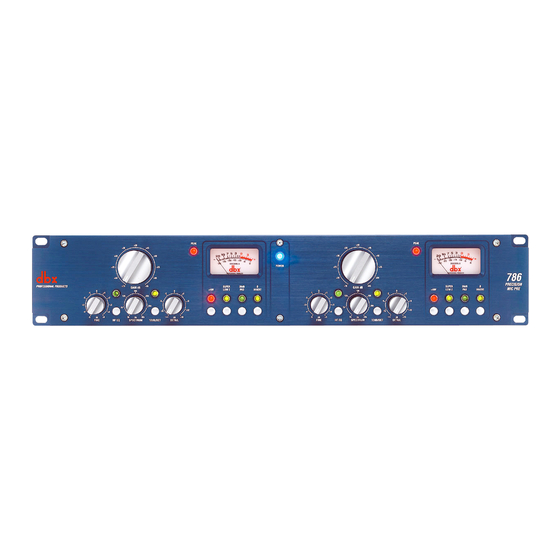- ページ 5
アンプ dbx 786のPDF オーナーズマニュアルをオンラインで閲覧またはダウンロードできます。dbx 786 16 ページ。 Precision mic preamp

Understanding Console Signal Path
Recording and PA consoles operate at a nominal level of +4dBu, while microphones operate at a level
of typically about -50dBu. Microphone signals must be amplified to the appropriate level for a console
to process it properly. If a signal is not raised to the appropriate level, the signal will be "masked" by
the console's internal noise, especially when one tries to increase the level of a low signal using the con-
sole fader or gain knob. All consoles have a preamp (usually labeled "Gain") as the first stage of an input
strip, allowing the user to boost a signal to an appropriate level before the other processes of the input
strip act upon the signal (EQ, dynamics, panning, etc.) Unfortunately, console preamp circuits are often
not given enough room on the circuit board, or high-quality parts. It is for this reason that outboard pre-
amps have become so popular. See Figure 1 below for a typical input strip's signal flow.
1/4"line
input
XLR mic
input
1/4" output
1/4" input
Equalization
Mic / Line
Switch
Phase Rev.
Switch
Send
Inserts
Return
EQ in/out
Aux Sends
1/4" output
Direct Out
Gain
- Preamp
Lo-Cut
Filter
Buss to
Main Outputs
and Group
Routing
Pan
Mute
Switch
switch
Fader
Introduction
786
Figure 1: Signal flow of
Typical
Console
Strip.
The gain, or preamp stage
occurs before all audio-
critical processes act upon
the incoming signal. The
preamp's "color" is then
processed as part of the
signal.
The only processes ahead
of the preamp stage are the
input selection stage, and
the phase reverse switch.
Input
3
